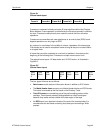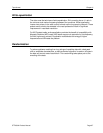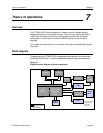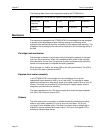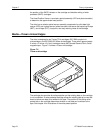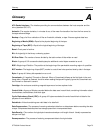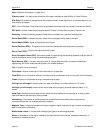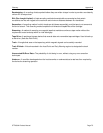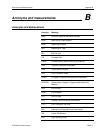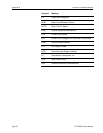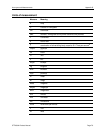
Appendix A Glossary
Page 74 STT8000A Product Manual
Dew—
Collection of moisture in a tape drive.
Directory track
—The track at the centerline of the tape, identified as track 254 by its Track ID frame.
Disc Drive—
A peripheral storage device that rotates the disk, writes data onto it, and reads data from it as
instructed by a program.
ECC
—(Error Correction Code) Special drive generated information that can be used to correct bad blocks.
ECC block—
A block containing drive-generated ECC data in its data field and part of control field.
Encoding—
A method whereby a group of data bits is translated into a group of recording bits.
End-of-Data (EOD)—
Indicates the point where the host stopped writing data to the tape.
End-of-Media (EOM)—
Equal to the physical end of tape.
End-of-Partition (EOP)
—The position at the end of the permissible recording area of a partition.
End of Tape (EOT)—
Equal to the logical end of the tape.
Error Correction Codes (ECC)-
Information written on tape during the recording operation that can later be
used to reconstruct errors during the data reading operation.
Early Warning (EW)—
The early warning marker is a single hole punched in the tape to indicate the
approaching end of the usable recording area in the forward direction.
File—
A logical unit of information.
Filler block—
A block containing no valid information in its data field.
Fixed Disk—
A non-removable hard disk. All data must be transferred to and from the disk via the computer.
Frame—
A group of 128 blocks forming a complete logical group.
Full-high (or full-height)—
Usually refers to a tape drive fitting in a vertical space of 3-1/2 inches.
Half-high (or half-height)—
Refers to the size of tape drive occupying a vertical space of about 1-1/2
inches.
Head Clog—
Particles from the tape or from outside the drive adhere to the head gap on a read or write
head and obstruct the reading or writing of data.
Interleaving—
The process of shuffling the order of data blocks before writing them to tape so the
consecutive bytes are not recorded physically adjacent.
Magnetic Tape—
A tape that accepts and retains magnetic signals intended for input, output, and storage of
data for information processing.
Media Header block
—A unique block identifying the type of format being recorded.
Noise—
A disturbance of the signal caused by the read channel, write channel, head/tape interaction, or
conducted or radiated sources.



